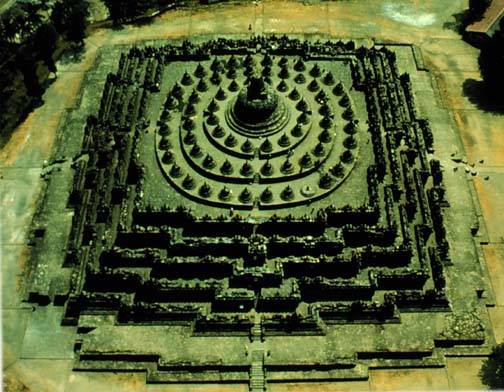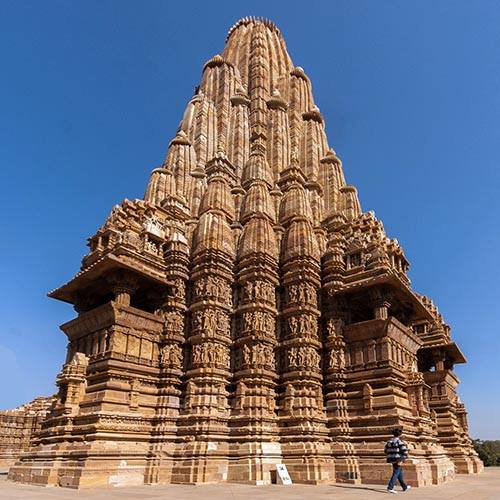Art of Architecture

e are Spirit first, corporeal second and in the physical world, art and architecture are expressions of humans. L5 Design's slogan was "Architecture is an extension of the human body." The slogan is transferred to In-Vesica because all work is influenced by Spirit. Through cultural distinctions that reflect experiences guided by spiritual and religious beliefs, the common thread throughout all of them is the human form, more or less, and its limited abilities.

Divine Goddess Within by Allison L. Williams Hill
A lot of Bragdon's observations are appreciated but as I think of my education, in and out of the classroom and the limited focus of the American curriculum, his reflects this: African; South American, and other civilizations of color are omitted. Dr. Ivan von Seritma's professors told him to his face that Africa did not have a history, or a culture worth studying. By its omission, Claude Bragdon is stating the same.

One of the advantages of a thorough assimilation of what may be called the theosophic idea is that it can be applied with advantage to every department of knowledge and of human activity: like the key to a cryptogram it renders clear and simple that which before seemed intricate and obscure. Let us apply this key to the subject of art, and to the art of architecture in particular, and see if by so doing we may not learn more of art than we knew before, and more of theosophy too.

Ancient Borobudur temple, Jogjarkata, Indonesia
"The Art of Architecture" from The Beautiful Necessity
by Claude Bragdon, FAIA
"The theosophic idea is that everything is an expression of the Self--or whatever other name one may choose to give to that immanent unknown reality which forever hides behind all phenomenal life--but because, immersed as we are in materiality, our chief avenue of knowledge is sense perception, a more exact expression of the theosophic idea would be: Everything is the expression of the Self in terms of sense. Art, accordingly, is the expression of the Self in terms of sense. Now though the Self is _one_, sense is not one, but manifold: and therefore there are _arts_, each addressed to some particular faculty or group of faculties, and each expressing some particular quality or group of qualities of the Self. The white light of Truth is thus broken up into a rainbow-tinted spectrum of Beauty, in which the various arts are colors, each distinct, yet merging one into another--poetry into music; painting into decoration; decoration becoming sculpture; sculpture--architecture, and so on."

Hindu temple
In such a spectrum of the arts each one occupies a definite place, and all together form a series of which music and architecture are the two extremes. That such is their relative position may be demonstrated in various ways. The theosophic explanation involving the familiar idea of the "pairs of opposites" would be something as follows. According to the Hindu-Aryan theory, Brahma, that the world might be born, fell asunder into man and wife--became in other words _name and form_[A]
The two universal aspects of name and form are what philosophers call the two "modes of consciousness," one of time, and the other of space. These are the two gates through which ideas enter phenomenal life; the two boxes, as it were, that contain all the toys with which we play. Everything, were we only keen enough to perceive it, bears the mark of one or the other of them, and may be classified accordingly. In such a classification music is seen to be allied to time, and architecture to space, because music is successive in its mode of manifestation, and in time alone everything would occur successively, one thing following another; while architecture, on the other hand, impresses itself upon the beholder all at once, and in space alone all things would exist simultaneously.
Music, which is in time alone, without any relation to space; and architecture, which is in space alone, without any relation to time, are thus seen to stand at opposite ends of the art spectrum, and to be, in a sense, the only "pure" arts, because in all the others the elements of both time and space enter in varying proportion, either actually or by implication. Poetry and the drama are allied to music inasmuch as the ideas and images of which they are made up are presented successively, yet these images are for the most part forms of space. Sculpture on the other hand is clearly allied to architecture, and so to space, but the element of _action_, suspended though it be, affiliates it with the opposite or time pole. Painting occupies a middle position, since in it space instead of being actual has become ideal--three dimensions being expressed through the mediumship of two--and time enters into it more largely than into sculpture by reason of the greater ease with which complicated action can be indicated: a picture being nearly always time arrested in midcourse as it were--a moment transfixed.

The Hermes' Temple by Allison L. Williams Hill
In order to form a just conception of the relation between music and architecture it is necessary that the two should be conceived of not as standing at opposite ends of a series represented by a straight line, but rather in juxtaposition, as in the ancient Egyptian symbol of a serpent holding its tail in its mouth, the head in this case corresponding to music, and the tail to architecture; in other words, though in one sense they are the most-widely separated of the arts, in another they are the most closely related.

Thai temple interior by Clement E. Hill, II, Ph.D.
Music being purely in time and architecture being purely in space, each is, in a manner and to a degree not possible with any of the other arts, convertible into the other, by reason of the correspondence subsisting between intervals of time and intervals of space. A perception of this may have inspired the famous saying that architecture is _frozen music_, a poetical statement of a
philosophical truth, since that which in music is expressed by means of harmonious intervals of time and pitch, successively, after the manner of time, may be translated into corresponding intervals of architectural void and solid, height and width.

The Great Sumerian Ziggurat of Ur 2
In another sense music and architecture are allied. They alone of all the arts are purely creative, since in them is presented, not a likeness of some known idea, but _a thing-in-itself_ brought to a distinct and complete expression of its nature. Neither a musical composition nor a work of architecture depends for its effectiveness upon resemblances to natural sounds in the one case, or to natural forms in the other. Of none of the other arts is this to such a degree true: they are not so much creative as re-creative, for in them all the artist takes his subject ready made from nature and presents it anew according to the dictates of his genius.

The characteristic differences between music and architecture are the same as those which subsist between time and space. Now time and space are such abstract ideas that they can be dealt with best through their corresponding correlatives in the natural world, for it is a fundamental theosophic tenet that nature everywhere abounds in such correspondences; that nature, in its myriad forms, is indeed the concrete presentment of abstract unities. The energy which everywhere animates form is a type of time within space; the mind working in and through the body is another expression of the same thing.

Correspondingly, music is dynamic, subjective, mental, of one dimension; while architecture is static, objective, physical, of three dimensions; sustaining the same relation to music and the other arts as does the human body to the various organs which compose, and consciousnesses which animate it (it being the reservatory of these organs and the vehicle of these consciousnesses); and a work of architecture in like manner may and sometimes does include all of the other arts within itself. Sculpture accentuates and enriches, painting adorns, works of literature are stored within it, poetry and the drama awake its echoes, while music thrills to its uttermost recesses, like the very spirit of life tingling through the body's fibres.

Such being the relation between them, the difference in the nature of the ideas bodied forth in music and in architecture becomes apparent. Music is interior, abstract, subjective, speaking directly to the soul in a simple and universal language whose meaning is made personal and particular in the breast of each listener: "Music alone of all the arts," says Balzac, "has power to make us live within ourselves." A work of architecture is the exact opposite of this: existing principally and primarily for the uses of the body, it is like the body a concrete organism, attaining to esthetic expression only in the reconciliation and fulfilment of many conflicting practical requirements. Music is pure beauty, the voice of the unfettered and perpetually vanishing soul of things; architecture is that soul imprisoned in a form, become subject to the law of causality, beaten upon by the elements, at war with gravity, the slave of man. One is the Ariel of the arts; the other, Caliban.

Ancient African house, Togo, Benin
Coming now to the consideration of architecture in its historical rather than its philosophical aspect, it will be shown how certain theosophical concepts are applicable here. Of these none is more familiar and none more fundamental than the idea of reincarnation. By reincarnation more than mere physical re-birth is meant, for physical re-birth is but a single manifestation of that universal law of alternation of state, of animation of vehicles, and progression
through related planes, in accordance with which all things move, and as it were make music--each cycle complete, yet part of a larger cycle, the incarnate monad passing through correlated changes, carrying along and bringing into manifestation in each successive arc of the spiral the experience accumulated in all preceding states, and at the same time unfolding that power of the Self peculiar to the plane in which it is momentarily manifesting.

Ethiopian church carved from single piece of rock
This law finds exemplification in the history of architecture in the orderly flow of the building impulse from one nation and one country to a different nation and a different country: its new vehicle of manifestation; also in the continuity and increasing complexity of the development of that impulse in manifestation; each "incarnation" summarizing all those which have gone before, and adding some new factor peculiar to itself alone; each being a growth, a life, with periods corresponding to childhood, youth, maturity and decadence; each also typifying in its entirety some single one of these life-periods, and revealing some special aspect or power of the Self.
Links

The above meditation mandala will be available soon.



















